The true story of Amarone
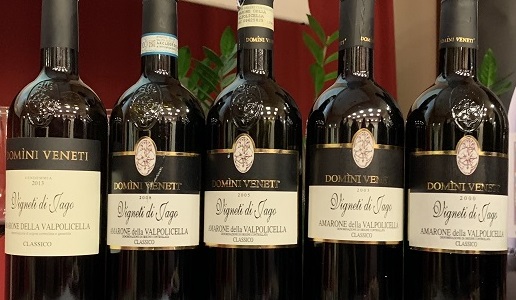
This was the title of a master class staged at the Valpolicella Negrar winery
The Valpolicella Negrar winery is a cooperative in the Verona Classico appellation that believes in research, innovation and collaboration to achieve solid and shared knowledge. Founded in 1933, today it brings together 230 small wine growers who together have 733 hectares of vineyards. Last November 18, they organized a tasting centered on Amarone in order to illustrates its stylistic evolution and the capacity of its native varietals to adapt to the climate.
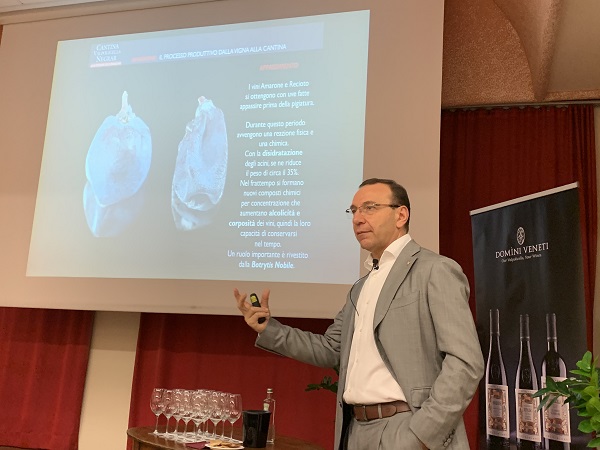
Next on stage was Daniele Accordini, the enologist at the Valpolicella Negrar winery, who explained what Amarone is and, in particular, the Vigneti di Jesi cru, for which he codified the vintages offered at the tasting based on average temperatures, rainfall, temperatures variations and when the harvest took place. The year 1987 was benchmark for the average annual rise in temperatures on a European level. Since 1987, average temperatures have risen by 3°C and there has been a sharp reduction in the fog that used to blanket the area and as well as the diurnal temperature variations. Despite this, the native varietals used in Valpolicella – Corvina, Corvinone and Rondinella – have adapted to these changes, as have other native and late harvest grapes in the area.
Amarone Classico della Valpolicella Vigneti di Jago Domini Veneti epitomizes what Accordini said. The grapes come from one of the Valpolicella Negrar winery’s cru and it produces 25-27,000 bottles a year. The vines are pergola veronese trained and grow on a terraced hillside held up by stone walls. The soil in the Negrar Valley has little organic substances and is rich in gravel, which provides good drainage, and has a significant amount of marl. Assisted by ONAV sommelier Alessandro Brizi, Accordini explained the five different vintages offered at the tasting.
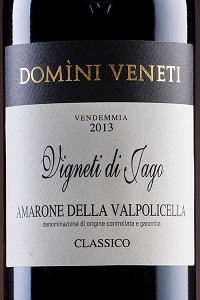 Amarone Classico della Valpolicella Vigneti di Jago Domìni Veneti 2013
Amarone Classico della Valpolicella Vigneti di Jago Domìni Veneti 2013
94/100 - € 40,00
2013: a late year and thus excellent to allow the grapes to ripen properly.
A blend of 60% Corvina, 15% Corvinone and 15% Rondinella with the remaining 10% composed of varietals allowed by production regulations. The wine matures in barriques and then ages long in the bottle. The color is an intense and lively ruby that is slightly garnet on the edge. The tense aroma has some green hints and scents of fruit preserved in alcohol while notes of stewed prunes, cloves and nutmeg that embellish the bouquet and make it wrapping. The tannic and toasted notes in the mouthfeel recall tobacco, chocolate and cocoa powder along with sensations of caramel and vanilla. The flavor, already very complex, is also succulent, fresh and saline. The long finish has a persistent and alternating sensation between the acidity and the tannins before ending with elegance.
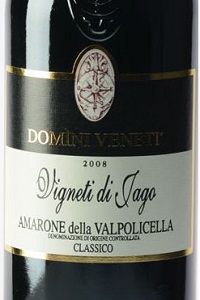 Amarone Classico della Valpolicella Vigneti di Jago Domìni Veneti 2008
Amarone Classico della Valpolicella Vigneti di Jago Domìni Veneti 2008
88/100 - € 40,00
2008: an early year led to an early harvest.
A blend of 60% Corvina, 15% Corvinone and 15% Rondinella with the remaining 10% composed of varietals allowed by production regulations. The wine matures in barriques and then ages long in the bottle. A ruby color that is still lively. The aroma is immediate with notes of marasca and black cherries, evolved fruit with some oxidized hints, sensations of sweetness and fullness. It is also quite balsamic and spicy with hints of baked black olives. The mouthfeel is consistent with the aroma and is soft, evolved and complex with a medium persistence and a warm and alcoholic finish.
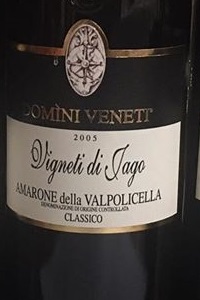 Amarone Classico della Valpolicella Vigneti di Jago Domìni Veneti 2005
Amarone Classico della Valpolicella Vigneti di Jago Domìni Veneti 2005
89/100 - € 40,00
2005: an intermediate year.
A blend of 60% Corvina, 15% Corvinone and 15% Rondinella with the remaining 10% composed of varietals allowed by production regulations. The wine matures in barriques and then ages long in the bottle. A brick-red color with a garnet edge. The bouquet has intriguing notes of cinchona, sweet spice like cinnamon with hints of nutmeg and cloves and closes on scents of chocolate and bitter cocoa. The mouthfeel is surprisingly full and creamy but an acidic streak is not lacking while the flavor has hints of citrus peel, like kumquat, and sensations of tamarind, in particular.
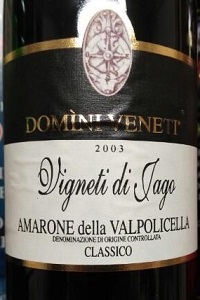 Amarone Classico della Valpolicella Vigneti di Jago Domìni Veneti 2003
Amarone Classico della Valpolicella Vigneti di Jago Domìni Veneti 2003
91/100 - € 40,00
2003: a very hot year with an exceptionally early harvest starting on August 26.
A blend of 60% Corvina, 15% Corvinone and 15% Rondinella with the remaining 10% composed of varietals allowed by production regulations. The wine matures in barriques and then ages long in the bottle. A surprising drop especially considering how hot it was. The color is transparent and still ruby but the edge is distinctly garnet. The bouquet has balsamic notes and those of rosemary and laurel. The mouthfeel has achieved a balance with the aroma and is fresh, enlivened by a sensation of blood orange, and slightly dry, especially in the finish which is very long. A biting wine but one that impressed me.
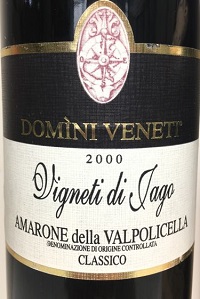 Amarone Classico della Valpolicella Vigneti di Jago Domìni Veneti 2000
Amarone Classico della Valpolicella Vigneti di Jago Domìni Veneti 2000
90/100 - € 40,00
2000: a balanced and regular year.
A blend of 60% Corvina, 15% Corvinone and 15% Rondinella with the remaining 10% composed of varietals allowed by production regulations. The wine matures in barriques and then ages long in the bottle. A red-brick color with a garnet edge. The aroma has immediate notes of caramel, sweet cocoa and medicinal herbs that shift towards dates. This year as well has notes of kumquat in the mouthfeel that is overall elegant with a pleasing sensation thanks to a freshness that is still lively and persistent.

 Italiano
Italiano














